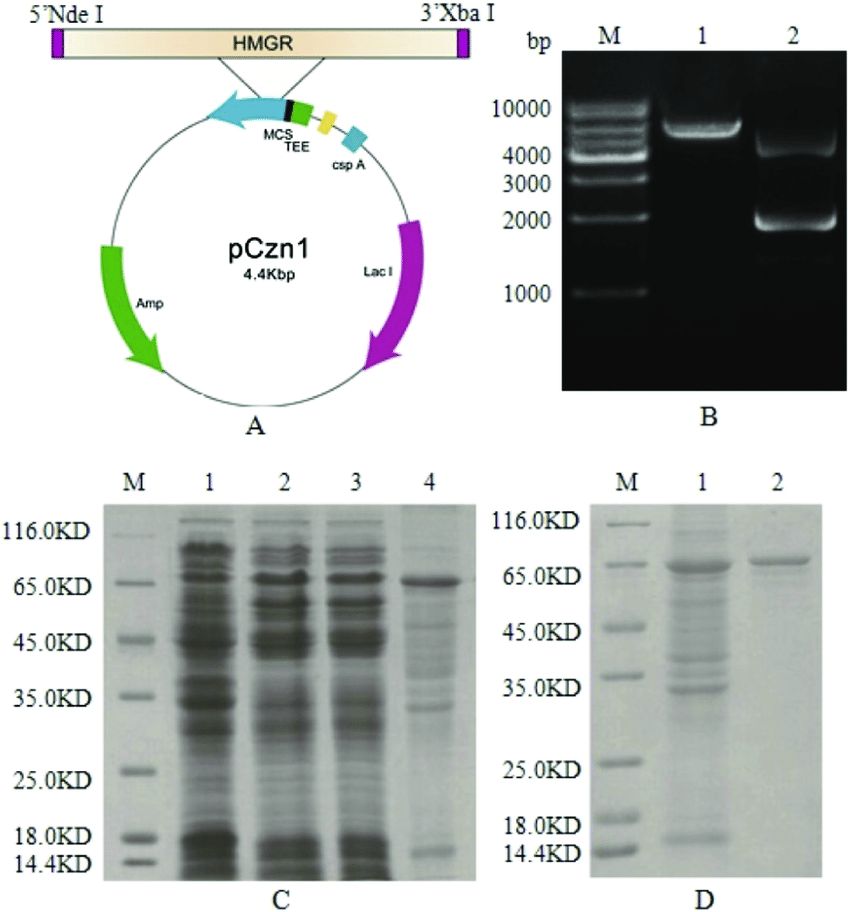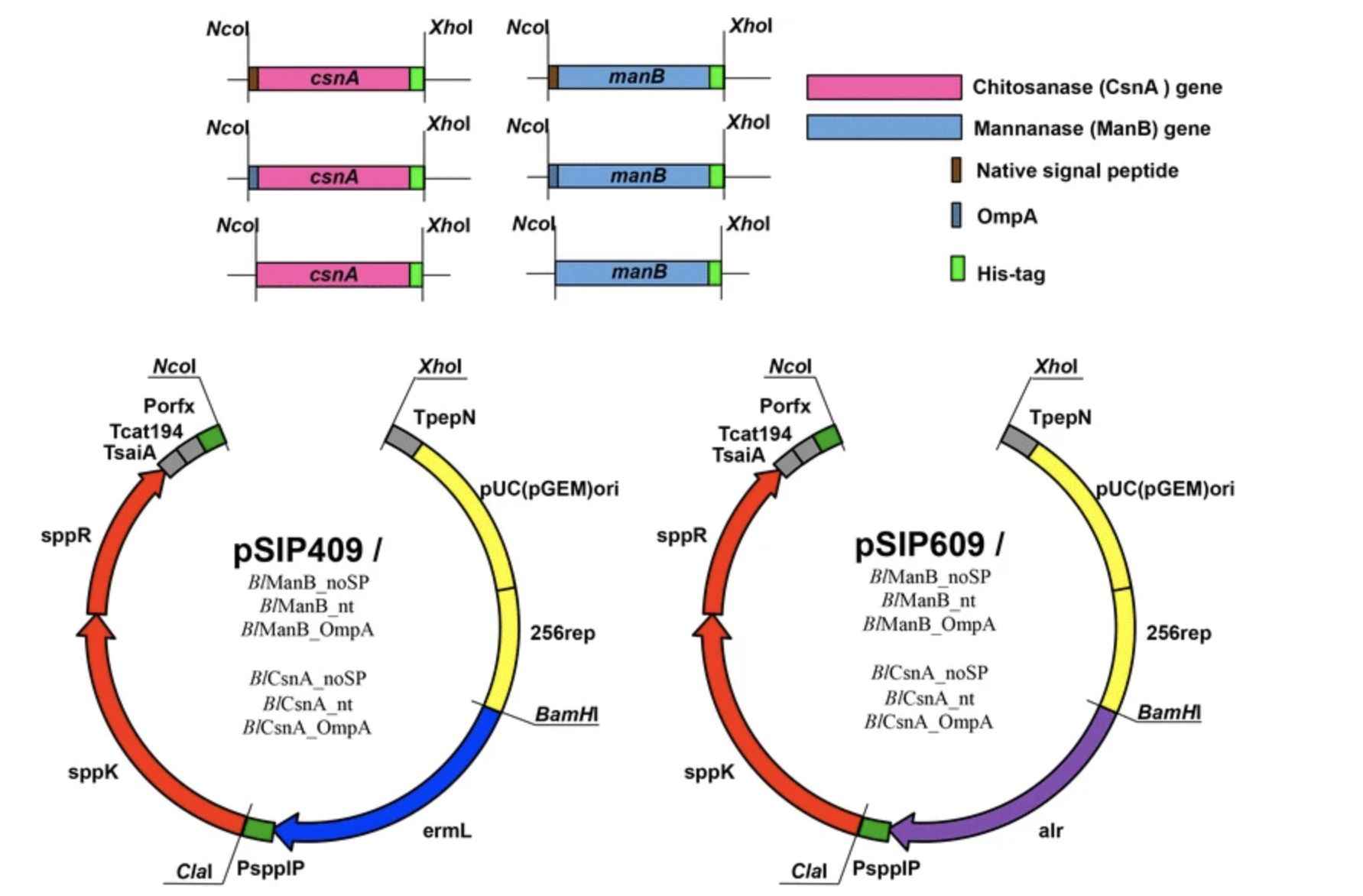Constructing an Enzyme Recombinant Expression Vector is a crucial process in molecular biology and biotechnology. It involves inserting a specific gene into a foreign host cell, enabling the host cell to produce the target protein. This process is vital in studying enzyme genes and plasmid synthesis. It allows for the synthesis and analysis of enzymes in a controlled environment. This control is critical for understanding their structure and function, and for developing new therapeutic strategies.
 Enzyme Recombinant Expression Vector Construction (Wei Gu, et al., 2015)
Enzyme Recombinant Expression Vector Construction (Wei Gu, et al., 2015)
Service Process
The following is an overview of our five-step process involved in constructing recombinant expression vectors for enzymes:
- Design and Synthesis of Gene: The journey begins with the first phase, which involves the meticulous design and synthesis of the gene of interest. This stage is of paramount importance because it sets the groundwork for the steps that follow. It is here that we lay the foundation for the subsequent phases of the process.
- Gene Insertion into Expression Vector: After the gene has been successfully synthesized, we proceed to the next stage where it is inserted into what we refer to as the expression vector. The role of the vector is akin to a transport vehicle; its job is to safely and efficiently deliver the gene to the host cell.
- Transformation of Host Cell: The third step in our process is the transformation of the host cell with the expression vector. We employ a variety of methods to integrate the gene into the host cell. This ensures the survival and functionality of the gene within its new environment.
- Cultivation of Transformed Cells: Once the host cell has been transformed, we take the next step, which involves culturing the cell within a controlled environment. This stage is critical as it creates the conditions necessary for the expression of the protein.
- Protein Purification and Analysis: Finally, we arrive at the last step wherein the expressed protein is purified and subjected to rigorous analysis to confirm its functionality and integrity. This thorough examination makes certain that the protein meets all required standards and is fit for its intended purpose.
We're here to assist you. If you have any questions, need more information, or would like to discuss a potential project, please don't hesitate to contact us. Our team is always eager to help and share our expertise.
Applications
| Application |
Description |
| Biotechnology |
Enzyme Recombinant Expression Vector Construction plays a vital role in biotechnology by enabling the production of recombinant enzymes in host organisms for various applications. This process involves the design and construction of expression vectors containing the genes encoding target enzymes, along with regulatory elements such as promoters, signal peptides, and selection markers. These vectors facilitate the efficient expression and secretion of enzymes in host cells, allowing for their large-scale production and utilization in biotechnological processes, including industrial biocatalysis, pharmaceutical production, and metabolic engineering. |
| Pharmaceutical Research |
Enzyme Recombinant Expression Vector Construction is essential in pharmaceutical research for the production of therapeutic proteins, enzymes, and antibodies. Expression vectors are designed to efficiently express target genes in host cells, allowing for the production of recombinant proteins for drug discovery, development, and biopharmaceutical manufacturing. These vectors enable the high-yield expression of bioactive molecules, facilitating research into novel drug candidates, disease mechanisms, and therapeutic interventions. |
| Agricultural Biotechnology |
In agricultural biotechnology, Enzyme Recombinant Expression Vector Construction is employed for the development of genetically modified crops with improved traits, such as enhanced resistance to pests, diseases, and environmental stresses. Expression vectors are used to introduce genes encoding beneficial enzymes or proteins into plant genomes, enabling the expression of desired traits for increased yield, quality, and sustainability in agriculture. These vectors facilitate the genetic engineering of crops for traits such as enhanced nutrient uptake, drought tolerance, and pest resistance, contributing to global food security and agricultural sustainability. |
| Environmental Bioremediation |
Enzyme Recombinant Expression Vector Construction plays a role in environmental bioremediation by facilitating the production of recombinant enzymes for the degradation and detoxification of environmental pollutants. Expression vectors are designed to express genes encoding enzymes capable of breaking down contaminants such as hydrocarbons, pesticides, and industrial chemicals. These vectors enable the deployment of engineered microorganisms or enzyme formulations for bioremediation applications, contributing to the cleanup and restoration of contaminated soil, water, and air environments. |
| Industrial Fermentation Processes |
In industrial fermentation processes, Enzyme Recombinant Expression Vector Construction is employed for the production of enzymes and proteins used as biocatalysts in bioprocesses such as fermentation, biofuel production, and biochemical synthesis. Expression vectors are designed to express genes encoding enzymes with desired properties, including high activity, stability, and substrate specificity. These vectors enable the large-scale production of recombinant enzymes in microbial hosts such as bacteria, yeast, or fungi, facilitating the optimization and efficiency of industrial bioprocesses for the production of biofuels, pharmaceuticals, and biochemicals. |
Case Study
This case concentrates on the production of β-mannanase and chitosanase hydrolytic enzymes in Lactobacillus plantarum for biotechnological applications. The emphasis is on the construction of recombinant expression vectors, with varying enzyme forms, signal peptides, and selection markers being evaluated for their secretion efficiency. The approach involves engineering vectors that carry target genes, coupled with native and E. coli OmpA-derived signal peptides, to facilitate secretion into the culture medium. The pSIP409 and pSIP609 vectors are utilized for the expression of the enzymes, controlled by the Porfx promoter (also known as PsppQ). The vectors incorporate either an erythromycin resistance gene or an alanine racemase gene as a selection marker. Additionally, polyhistidine tags are included to simplify purification, and the 256rep replicon ensures DNA replication in L. plantarum. The enzymes are cloned in three forms, two of which include a signal peptide for secretion (native or OmpA). The genes marked in red constitute the two-component system needed for peptide-pheromone driven induction; the grey areas marked with a T are terminator sequences.
 Secretory production of a beta-mannanase and a chitosanase using a Lactobacillus plantarum expression system (Suttipong Sak-Ubol, et al., 2016)
Secretory production of a beta-mannanase and a chitosanase using a Lactobacillus plantarum expression system (Suttipong Sak-Ubol, et al., 2016)
FAQs
Presented below are a selection of commonly posed inquiries regarding the topic of Enzyme Recombinant Expression Vector Construction. Accompanying each question, you will find comprehensive answers that aim to thoroughly address each query and provide a deep understanding of the subject matter. If you have more specific or detailed questions, don't hesitate to get in touch with us directly.
Q: Could you elaborate on the purpose of Enzyme Recombinant Expression Vector Construction?
A: The main objective of Enzyme Recombinant Expression Vector Construction is to facilitate the production and examination of proteins in a regulated setting. This is an essential tool in the scientific world as it aids in understanding the behavior of these proteins and their potential applications across a variety of fields such as medicine, agriculture, and industry.
Q: Is it possible to insert any gene into an expression vector?
A: Yes, that is correct. As long as the sequence of the gene is known and can be synthesized, it can be successfully inserted into an expression vector. This allows the process to be highly adaptable and applicable for a vast array of genes, broadening its utility.
Q: Does the type of host cell have any effect on protein expression?
A: Yes, it certainly does. The choice of host cell can have a substantial impact on the expression levels and functionality of proteins. Different host cells may have varying capabilities when it comes to protein synthesis, folding, and post-translational modification.
Q: Could you provide examples of common host cells used?
A: In terms of common host cells utilized in this process, E.coli, yeast, and mammalian cells are frequently chosen. The specific choice of cell largely depends on the specific requirements of the protein that is intended to be expressed.
Q: How much time is typically needed for this process?
A: The timeframe for this process can range from a few weeks to a few months. The duration varies depending on the complexity of the protein and the specific conditions required for its expression.
Q: Can this process be used for the production of enzymes for industrial use?
A: Yes, certainly. This process can be scaled up for the industrial production of enzymes. This has significant implications for several industries, including biofuels, food and beverage, and pharmaceuticals, among others.
Q: Is the expressed protein always functional?
A: The functionality of the protein is dependent on its proper folding and post-translational modifications. These factors can vary depending on the host cell and other conditions, so the functionality of the expressed protein can also vary.
Q: Can the expression vector be stored for future use?
A: Indeed, the expression vector can be stored for future use. It can be used at a later date to transform host cells, which opens up the possibility for repeated or long-term studies.
Q: Is it possible to express multiple proteins simultaneously?
A: Yes, it is possible. Multiple genes can be inserted into the expression vector, which allows to produce multiple proteins. This capability is particularly useful in studying complex biological systems or producing multi-enzyme complexes.

































 Enzyme Recombinant Expression Vector Construction (Wei Gu, et al., 2015)
Enzyme Recombinant Expression Vector Construction (Wei Gu, et al., 2015) Secretory production of a beta-mannanase and a chitosanase using a Lactobacillus plantarum expression system (Suttipong Sak-Ubol, et al., 2016)
Secretory production of a beta-mannanase and a chitosanase using a Lactobacillus plantarum expression system (Suttipong Sak-Ubol, et al., 2016)